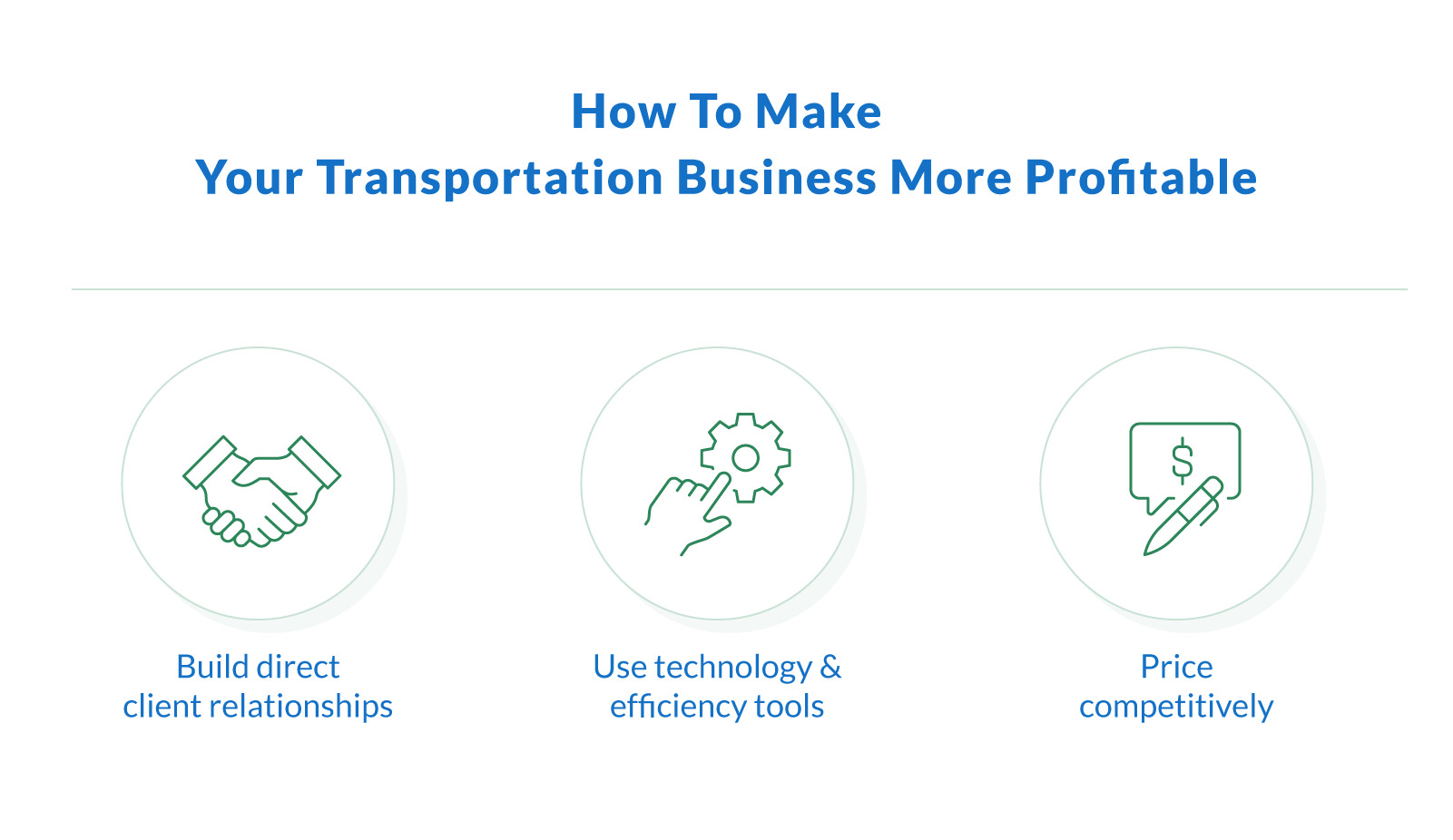Running a transportation business has always required grit, precision, and smart planning. But, today's market presents a new level of difficulty for entrepreneurs trying to grow a profitable business in a crowded and heavily regulated transportation industry. Whether you're operating a single truck or managing a growing fleet, staying financially stable is no easy task.
Many small business owners struggle with slim profit margins driven by broker fees, underpriced freight, and rising compliance costs. Startup carriers often face uphill battles in securing contracts and financing despite having a solid business plan and a viable type of transportation in mind. Meanwhile, larger companies undercut rates and dominate access to shippers, making it harder for new entrants to compete.
This article explores the most common financial hurdles in transportation services, including broker-related revenue cuts, market saturation, and increasing regulatory burdens. It also offers actionable strategies, such as freight rate negotiation, building direct shipper relationships, and cost optimization, to help make your operation more efficient and financially sound.
Financing Struggles of Transportation Business Owners
Running a transportation business can be rewarding — but staying profitable in a competitive industry is no easy task. Whether you're an owner-operator, managing a small fleet, or launching a new startup, balancing operational costs and revenue is a constant challenge. From freight brokers cutting into payouts to market competition and ever-changing regulations, transportation business owners face serious financial pressure.
Among the most pressing issues are low freight rates, broker dependence, and high startup costs. These struggles can crush profit margins, especially for new entrepreneurs without established networks. But with the right strategies — like smart freight rate negotiation and optimizing operations — transportation services can stay competitive and build a profitable business. Let's break down some of the top financial hurdles and how business owners in the transportation industry can tackle them head-on.
Broker Issues
Many small transportation and trucking businesses and independent owner-operators rely on brokers to find loads. While this can help keep trucks moving, it often comes at a steep cost. Freight brokers take a significant percentage of each load payment — sometimes leaving carriers with barely enough to cover fuel and maintenance. This dependence on intermediaries limits control over pricing and creates long-term revenue instability for transportation companies.
Adding to the problem, not all brokers operate within legal bounds. As noted by one Reddit user:
"Dispatchers cannot legally broker freight unless they are licensed as freight brokers and meet FMCSA requirements, including holding a $75,000 surety bond. If a dispatcher solicits freight directly from a shipper and arranges transportation without a broker's license, they are engaging in illegal activity."
This highlights how unlicensed brokers — or dispatchers acting as brokers without proper credentials — may take a cut of the payment without regulatory oversight. That adds risk and reduces earnings for
This user also shared:
"There is an ongoing debate in the trucking industry about dispatch services, with some stakeholders arguing that certain dispatchers operate as unlicensed brokers."
The core issue is that brokers, whether licensed or not, often underpay carriers while charging shippers significantly more. This margin squeeze erodes the profit margin for trucking business owners and inflates operational costs without adding real value. Until providers gain more control over freight pricing and client relationships, many transportation companies will remain at the mercy of broker-driven deals.
Strategy: Negotiate Better Freight Rates
One of the most effective ways to boost profitability is through smarter freight rate negotiation. Truckers who understand their cost structure and leverage real-time market data can avoid low-paying loads and secure contracts that actually cover their expenses — and then some.
Start with a clear understanding of your Cost Per Mile (CPM). As a Reddit user points out:
"You cannot be a successful trucking business owner if you don't know your CPM — Cost Per Mile. You need to know what it costs anytime your truck moves a mile. With this understanding, you can negotiate your RPM - Rate Per Mile efficiently."
This is the foundation for competitive pricing. Without it, you're guessing — and that's dangerous in the trucking industry. Once you've nailed down your CPM, set your Rate Per Mile (RPM) to exceed your costs and account for your desired profit margin.
As the same Reddit user adds:
"To ensure profitability, your RPM should be higher than your CPM. Consider your desired profit margin and market rates when setting your RPM."
Here are a few ways transportation business owners can negotiate better rates:
Know your numbers. Understanding your fixed and variable operational costs is essential when setting profitable RPMs.
Use load boards strategically. Look for platforms that provide real-time rate data and compare offers before accepting a load.
Build direct relationships with shippers. Cutting out brokers gives you more pricing control and often leads to longer-term, higher-paying contracts.
Leverage technology. Use tools that track lane pricing trends and automate rate analysis to ensure you're getting the best deal available.
Effective freight rate negotiation is key to staying competitive. Truckers who price strategically based on real-time data and cost analysis can reduce risk, boost profit margins, and build a more sustainable business in a tough transportation sector.
Market Saturation & Competition
The transportation industry has seen a wave of new startups and independent operators in recent years, driven by increasing demand for shipping and delivery services. But this surge in new entrants has led to market saturation, making it harder for small businesses to stay afloat. As more carriers enter the space, competition intensifies — pushing rates down and putting pressure on profit margins.
Startups and small transportation companies often compete with larger providers that can offer lower pricing thanks to economies of scale. These bigger players cut costs through volume, leaving smaller operations with little room to match their rates while staying profitable. This creates a tough environment for entrepreneurs trying to build a cost-effective business model from scratch.
As one Reddit user shared:
"...the majority of carriers (your competition) [will] accept anything just to keep wheels turning."
This highlights how many carriers are forced to accept low-paying loads just to stay operational, even if the rates barely cover their costs. The result is a race to the bottom — one where owner-operators struggle to secure contracts that reflect the value of their services.
The same Reddit user pointed out:
"Trucking is the only business where the customer determines the price and contractual rules."
This underscores a key imbalance in the transportation sector. Shippers and brokers often dictate pricing and terms, leaving little room for carriers to negotiate or push back. Truckers are expected to deliver under rigid conditions — without the leverage to charge what their time and resources are truly worth.
They also shared:
"FedEx made $45k worth of shipping fees on that one truck shipment and a single tank of gas. Yet the average carrier will deliver that load for $1200 next-day delivery and allow 4 hrs free time for loading and unloading at $35-$50 detention while paying $3-$4 per gallon for fuel. It's simply absurd."
This illustrates the growing gap between what shippers charge customers and what carriers actually receive. Large logistics firms are able to capture enormous margins, while smaller providers are left chasing loads that barely pay the bills.
As competition intensifies, transportation business owners need to adapt their business model, find smarter ways to serve a high-demand market and pursue transportation business ideas that stand out.
Strategy: Diversify Your Services
Diversifying your service offerings can open new revenue streams and reduce dependence on standard load boards or low-paying freight contracts.
Offering niche services allows you to tap into areas of high demand with less competition. For example, non-emergency medical transportation (NEMT) is growing as more healthcare providers look for reliable ways to help patients reach medical appointments. Similarly, last-mile delivery and courier services are booming as e-commerce expands and consumer expectations around fast shipping continue to rise.
Here are a few diversification options worth exploring:
NEMT. Partner with hospitals, clinics, or insurance providers to transport patients to and from health care appointments.
Specialized equipment hauling. Invest in gear that lets you carry oversized or temperature-sensitive freight — services many carriers can't offer.
Delivery service and warehousing. Provide storage and distribution solutions to ecommerce retailers or local businesses looking to streamline their supply chain.
Sustainability-focused solutions. Consider offering electric vehicle delivery services or carbon-offset options for eco-conscious clients.
Regulatory Burdens
Regulatory compliance is one of the most overlooked but financially draining aspects of running a trucking company. From securing a business license and completing vehicle registration to meeting DOT safety standards and maintaining liability insurance, the process is loaded with hidden costs. These requirements are non-negotiable, and falling behind can lead to costly fines or even shutdowns.
For small business owners and startups, the regulatory burdens can feel overwhelming — especially before the first paying job even hits the books. A Reddit user shared their experience:
"For the last month, I've been sinking most of my money into setting up a freight-moving company with a guy who has a class A CDL....we were planning to make our money based on the deals we saw in the DAT One app, but after finally going through all the bureaucracy of forming an IRP, verifying insurance, certifications, etc."
This highlights the reality: launching a trucking business means investing heavily in paperwork, certifications, and insurance coverage long before the wheels even hit the road.
The Reddit user added:
"I really thought after we spent over a month paying fees, filling out forms, taking tests, gathering certifications, etc., that we'd be making enough money to pay for the truck/insurance."
Many new business owners underestimate just how expensive and time-consuming compliance can be. Between liability insurance, driver's license requirements, and registering a vehicle under the correct operating authority, the startup costs can eat into available capital — making early profitability a challenge.
Even after meeting every regulation, new businesses face another hurdle. As that same Reddit user warned:
"Do not try to make a new company from scratch; brokers won't take on new companies."
This reflects a real problem in the transportation industry. Many brokers hesitate to work with unproven carriers, creating another layer of difficulty for new entrants. So, even if your paperwork is in perfect order, securing work can still be an uphill battle.
Between frequent rule changes, fluctuating insurance rates, and ever-tightening safety standards, operational costs tied to compliance continue to grow. Trucking business owners must budget carefully and stay organized to keep up.
Strategy: Optimize Costs & Plan for Compliance
To manage regulatory burdens effectively, business owners need a plan that focuses on cost optimization, proactive compliance, and smart use of available tools and programs.
Here are a few strategies to ease the financial strain:
Track deadlines and renewals. Use compliance software or calendar alerts to stay ahead of permit renewals, insurance deadlines, and safety checks. Avoiding late fees helps keep operational costs in check.
Budget for vehicle maintenance. Staying on top of routine maintenance prevents costly breakdowns and helps ensure compliance with safety regulations.
Monitor fuel costs and tolls. Use route optimization tools to avoid high-toll roads and reduce fuel usage, contributing to both sustainability and cost savings.
Apply for tax breaks and local grants. Many states and municipalities offer assistance for transportation startups investing in safety, eco-friendly practices, or job creation.
Bundle insurance coverage. Working with an agent who understands the transportation industry can help you get the right mix of liability, cargo, and vehicle insurance without overpaying.
How Transportation Business Owners Can Improve Profitability

In a competitive and cost-sensitive industry like transportation, increasing revenue isn't just about booking more loads — it's about working smarter. Whether you're running a startup or an established small business, improving profitability means cutting inefficiencies, setting better rates, and building more reliable revenue streams. Transportation business owners who take a proactive approach to operations, pricing, and customer relationships can gain an edge in the crowded trucking industry.
Here are three strategies to help improve your business model and stay competitive while delivering quality service.
Build Direct Client Relationships
Relying on brokers often means giving up a portion of your income and losing control over pricing. One of the most effective ways to improve profit margins and gain more stability is by working directly with clients. By building long-term relationships with shippers, healthcare providers, or logistics firms, transportation businesses can secure steady work while maintaining control over contract terms.
Developing strong partnerships also boosts customer satisfaction and strengthens your position in the transportation sector. Direct relationships give you more flexibility to align services with client needs — whether that means reliable delivery service for time-sensitive shipments or specialized routes for medical appointments.
Here are a few ways to build direct partnerships:
Identify your target market. Focus your outreach on industries that align with your services, such as retail, health care, or food distribution.
Use smart marketing strategies. Promote your services online, attend industry trade shows, and connect with potential clients through business directories or LinkedIn.
Emphasize quality service. Offer consistent, on-time deliveries and communicate proactively to build trust and win repeat business.
Use Technology & Efficiency Tools
The right tools can dramatically improve operations across any transportation or trucking company. From fuel efficiency to route planning, technology helps streamline day-to-day processes and lower operational costs. Tools like AI-powered logistics platforms, GPS fleet tracking, and fuel optimization software give truckers access to real-time data — leading to smarter decision-making and faster deliveries.
Efficiency tools also reduce downtime and vehicle maintenance expenses by monitoring performance and alerting operators to issues before they become costly repairs.
Here's how technology can support a more cost-effective operation:
Improve route optimization. Real-time mapping reduces fuel costs and ensures faster, more reliable delivery service.
Monitor vehicle maintenance. Fleet software can track mileage and service intervals, helping avoid breakdowns and unexpected expenses.
Automate administrative tasks. Use digital tools to manage load assignments, track documents, and stay ahead of compliance requirements.
Price Competitively
Pricing is one of the biggest levers for transportation businesses to improve profit margins — yet many small businesses struggle to find the right balance. Set your rates too low, and you risk operating at a loss. If you set them too high, you may lose work to larger providers. The key is developing a pricing model that reflects your actual costs and remains competitive in a high-demand market.
Start by factoring in all expenses: fuel costs, tolls, liability insurance, maintenance, and administrative overhead. Then, build your desired profit margin based on the standards of the trucking industry.
Here are some tips for setting competitive pricing:
Know your numbers. Break down your cost per mile and set a minimum rate that covers all expenses.
Adjust to market trends. Keep an eye on real-time rate fluctuations and adapt your pricing when necessary.
Offer flexible pricing packages. For long-term clients or high-volume contracts, consider volume discounts that protect your profit margin while remaining attractive to customers.
Pricing strategy is not one-size-fits-all. Small business owners who take a data-driven approach and adjust their pricing based on market conditions can stay profitable — even when demand or fuel prices shift.
Staying Profitable in Transportation
Transportation business owners face no shortage of financial challenges. From broker-related revenue cuts and market saturation to rising regulatory costs and shifting customer expectations, keeping operations profitable in the trucking industry requires more than just keeping wheels turning.
But with the right strategies, small business owners can overcome these hurdles. Negotiating better freight rates, cutting operational costs, and diversifying services can significantly improve profit margins. Leveraging technology for real-time tracking, vehicle maintenance, and route optimization also helps build a more cost-effective and sustainable business. And perhaps most importantly, building direct client relationships ensures better pricing control and long-term stability.
Success in this competitive sector starts with a solid business plan and a commitment to delivering quality service. Whether you're just starting out or looking to scale, now's the time to take action and set your transportation business on a path to becoming a more profitable business.
Need working capital to fund your next move? Apply now at Clarify Capital to explore fast, flexible financing options tailored to transportation services.

Emma Parker
Senior Funding Manager
Emma holds a B.S. in finance from NYU and has been working in the business financing industry for over a decade. She is passionate about helping small business owners grow by finding the right funding option that makes sense for them. More about the Clarify team →
Related Posts





